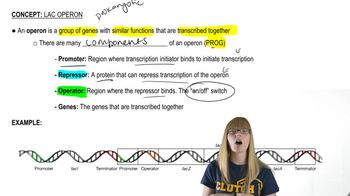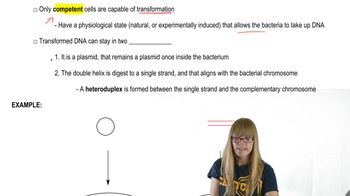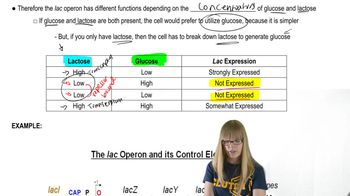Table of contents
- 1. Introduction to Genetics51m
- 2. Mendel's Laws of Inheritance3h 37m
- 3. Extensions to Mendelian Inheritance2h 41m
- 4. Genetic Mapping and Linkage2h 28m
- 5. Genetics of Bacteria and Viruses1h 21m
- 6. Chromosomal Variation1h 48m
- 7. DNA and Chromosome Structure56m
- 8. DNA Replication1h 10m
- 9. Mitosis and Meiosis1h 34m
- 10. Transcription1h 0m
- 11. Translation58m
- 12. Gene Regulation in Prokaryotes1h 19m
- 13. Gene Regulation in Eukaryotes44m
- 14. Genetic Control of Development44m
- 15. Genomes and Genomics1h 50m
- 16. Transposable Elements47m
- 17. Mutation, Repair, and Recombination1h 6m
- 18. Molecular Genetic Tools19m
- 19. Cancer Genetics29m
- 20. Quantitative Genetics1h 26m
- 21. Population Genetics50m
- 22. Evolutionary Genetics29m
12. Gene Regulation in Prokaryotes
Lac Operon
Problem 8b
Textbook Question
Describe the experimental rationale that allowed the lac repressor to be isolated.
 Verified step by step guidance
Verified step by step guidance1
Understand the lac operon model: The lac operon in E. coli is a set of genes involved in lactose metabolism, regulated by the lac repressor protein. The repressor binds to the operator region to inhibit transcription in the absence of lactose.
Identify the need for isolation: To study the lac repressor's function and structure, scientists needed to isolate it from other cellular components.
Use of mutant strains: Researchers used mutant strains of E. coli that had constitutive expression of the lac operon, meaning the operon was active even in the absence of lactose. These mutants had defects in the repressor protein or its binding site.
Develop a selection method: Scientists developed a method to select for cells that could not repress the lac operon, allowing them to identify and isolate the repressor protein. This involved using a substrate that would only be metabolized if the operon was active.
Purification techniques: Once potential repressor proteins were identified, biochemical techniques such as affinity chromatography were used to purify the lac repressor, allowing for further study of its properties and interactions.
Recommended similar problem, with video answer:
 Verified Solution
Verified SolutionThis video solution was recommended by our tutors as helpful for the problem above
Video duration:
2mPlay a video:
Was this helpful?
Key Concepts
Here are the essential concepts you must grasp in order to answer the question correctly.
Lac Operon
The lac operon is a set of genes in E. coli that are involved in the metabolism of lactose. It consists of structural genes (lacZ, lacY, and lacA) and regulatory elements, including the lac repressor. Understanding the lac operon is crucial for grasping how gene expression is controlled in response to environmental changes, particularly the presence or absence of lactose.
Recommended video:
Guided course

Lac Operon Overview
Repressor Proteins
Repressor proteins are molecules that bind to specific DNA sequences to inhibit the transcription of genes. In the case of the lac operon, the lac repressor binds to the operator region, preventing RNA polymerase from transcribing the downstream genes when lactose is absent. This mechanism is a key example of negative regulation in gene expression.
Recommended video:
Guided course

Proteins
Experimental Isolation Techniques
Experimental isolation techniques, such as affinity chromatography and gel electrophoresis, are methods used to purify specific proteins from complex mixtures. In the context of isolating the lac repressor, researchers utilized these techniques to separate the repressor from other cellular components, allowing for detailed study of its function and interaction with the lac operon.
Recommended video:
Guided course

Transformation

 4:27m
4:27mWatch next
Master Lac Operon Overview with a bite sized video explanation from Kylia Goodner
Start learning


